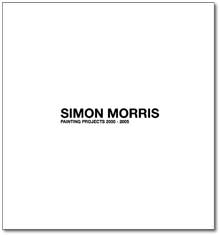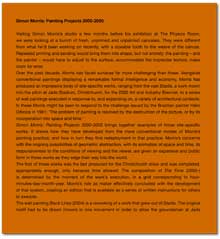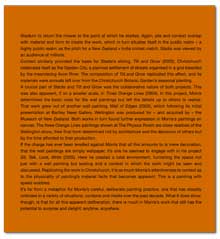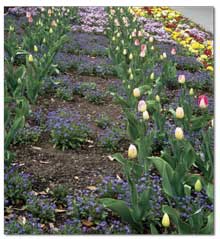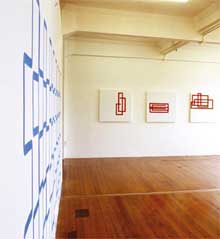 |
|||||||||
|
|
| ...PUBLICATIONS | ...Simon Morris - Essay by William McAloon | ||||||||||||||||
|
Simon Morris: Painting Projects 2000-2005 Visiting Simon Morris’s studio a few months before his exhibition at The Physics Room, we were looking at a bunch of fresh, unprimed and unpainted canvases. They were different from what he’d been working on recently, with a sizeable tooth to the weave of the canvas. Repeated priming and sanding would bring them into shape, but not entirely: the painting - and the painter - would have to adjust to the surface, accommodate the imprecise texture, make room for error. Over the past decade, Morris has faced surfaces far more challenging than these. Alongside conventional paintings displaying a remarkable formal intelligence and economy, Morris has produced an impressive body of site-specific works, ranging from the vast Stadia, a work mown into the pitch at Jade Stadium, Christchurch, for the 2002 Art and Industry Biennial, to a series of wall paintings executed in response to, and expanding on, a variety of architectural contexts. In these Morris might be seen to respond to the challenge issued by the Brazilian painter Hélio Oiticica in 1961: ‘The problem of painting is resolved by the destruction of the picture, or by its incorporation into space and time.’ Simon Morris: Painting Projects 2000-2005 brings together examples of those site-specific works. It shows how they have developed from the more conventional modes of Morris’s painting practice, and how in turn they find redeployment in that practice. Morris’s concerns with the ongoing possibilities of geometric abstraction, with its animation of space and time, its responsiveness to the conditions of viewing and the viewer, are given an expansive and public form in these works as they edge their way into the world. The first of those works was the last produced for the Christchurch show and was completed, appropriately enough, only because time allowed. The composition of The Time (2000 - ) is determined by the moment of the work’s execution, in a grid corresponding to hourminutes- day-month-year. Morris’s role as maker effectively concluded with the development of that system, creating an edition that is available as a series of written instructions for others to execute. The wall painting Black Lines (2004) is a reworking of a work that grew out of Stadia. The original motif had to be drawn (mown) in one movement in order to allow the groundsman at Jade Stadium to return the mower to the point at which he started. Again, site and context overlap with material and form to create the work, which in turn situates itself in the public realm - a highly public realm: as the pitch for a New Zealand v India cricket match, Stadia was viewed by an audience of millions. Context similarly provided the basis for Stadia’s sibling, Tilt and Grow (2002). Christchurch celebrates itself as the Garden City, a planned settlement of streets organised in a grid bisected by the meandering Avon River. The composition of Tilt and Grow replicated this effect, and its materials were annuals left over from the Christchurch Botanic Garden’s seasonal planting. A crucial part of Stadia and Tilt and Grow was the collaborative nature of both projects. This was also apparent, if on a smaller scale, in Three Orange Lines (2004). In this project, Morris determined the basic rules for the wall paintings but left the details up to others to realise. That work grew out of another wall painting, Wall of Edges (2002), which following its initial presentation at Bartley Nees Gallery, Wellington was produced for - and acquired by - the Museum of New Zealand. Both works in turn found further expression in Morris’s paintings on canvas. The three Orange Lines paintings shown at The Physics Room are close relatives of the Wellington show, their final form determined not by architecture and the decisions of others but by the time afforded to their production. If the charge has ever been levelled against Morris that all this amounts to is mere decoration, that the wall paintings are simply wallpaper, it’s one he seemed to engage with in his project Sit, Talk, Look, Write (2005). Here he created a total environment, furnishing the space not just with a wall painting but seating and a context in which the work might be seen and discussed. Replicating the work in Christchurch, it is as much Morris’s attentiveness to context as to the physicality of painting’s material facts that becomes apparent. This is a painting with speed wobbles. It’s far from a metaphor for Morris’s careful, deliberate painting practice, one that has steadily unfolded in a variety of situations, contexts and media over the past decade. What it does show, though, is that for all this apparent deliberation, there is much in Morris’s work that still has the potential to surprise and delight: anytime, anywhere. Essay by William McAloon from Simon Morris: Painting Projects 2000-2005 Companion to exhibition Simon Morris: Painting projects 2000-2005
|
||||||||||||||||
